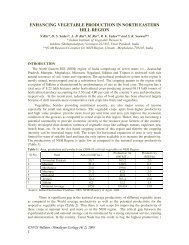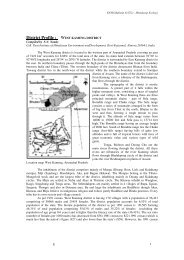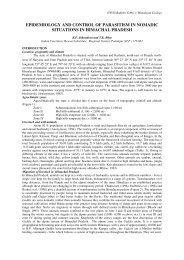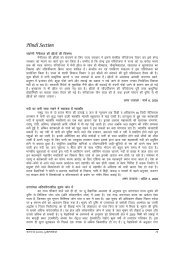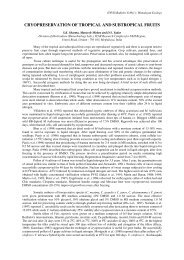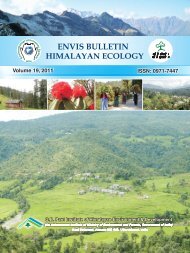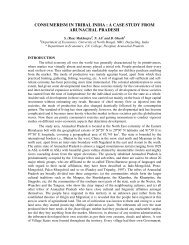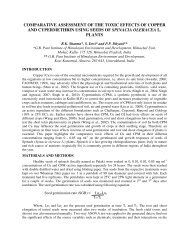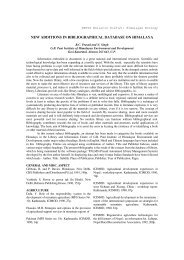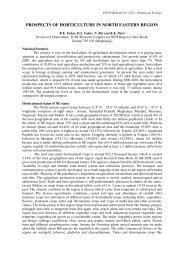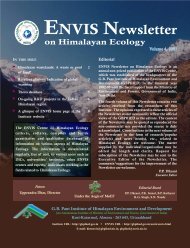found that the timber volume estimates using stratified random sampling technique were 15 per centmore accurate than simple random sampling. The satellite image-based inventory using stratifiedrandom sampling was found to have about 90% corresp<strong>on</strong>dence with the inventory d<strong>on</strong>e by the ForestDepartment.Lal, H.; Samra, J.S. and Arora, Y.K. 2003. Kinnow mandarin in Do<strong>on</strong> Valley: 2. Effect ofirrigati<strong>on</strong> and mulching <strong>on</strong> water use, soil temperature, weed populati<strong>on</strong> and nutrient losses.Indian J. Soil C<strong>on</strong>s., 31(3): 281-286. Central Soil and Water C<strong>on</strong>servati<strong>on</strong> Research and TrainingInstitute, Dehradun 248 195, Uttaranchal, India. [IRRIGATION; ORGANIC MULCHES; WATERUSE EFFICIENCY; WEED FLORA]A study was c<strong>on</strong>ducted <strong>on</strong> organic mulches and irrigati<strong>on</strong> to assess the performance of Kinnowmandarin in Do<strong>on</strong> Valley during 1999 to 2001 in a split plot design with four replicati<strong>on</strong>s. Thetreatments comprised of three frequencies of irrigati<strong>on</strong> based <strong>on</strong> CPF viz. 80, 160 and 240 mm andc<strong>on</strong>trol as main plot and two organic mulches viz. sal (Shorea robusta) and Lantana (Lantana camara)dry leaves @ 1 kg m -2 and c<strong>on</strong>trol as sub-plot. Kinnow plants irrigated at 80 mm CPE encouragedpopulati<strong>on</strong> and dry weight increase of weed and nutrient removal by weed but it also improved wateruse and seas<strong>on</strong>al water requirement, and produced 79.30 and 13 per cent more fruits than n<strong>on</strong>-irrigatedand irrigated plants at 240 and 160 mm CPE, respectively. Similarly, mulch of sal leaves minimisedwater use and water requirement, populati<strong>on</strong> and dry weight of weeds, nutrient removal by weed,improved weed c<strong>on</strong>trol efficiency, regulated soil temperature and produced 16.6 and 8.0 per cent morefruits than c<strong>on</strong>trol and Lantana mulch, respectively.Maikhuri, R.K.; Rao, K.S. and Saxena, K.G. 2004. Bioprospecting of wild edibles for ruraldevelopment in the Central <strong>Himalayan</strong> mountains of India. Mountain Ressearch and Development,24(2): 110-113. Garhwal Unit, G.B. Pant Institute of <strong>Himalayan</strong> Envir<strong>on</strong>ment and Development, P.O.Box 92, Srinagar, Garhwal 246 174, Uttaranchal, India. [CENTRAL HIMALAYA; DIVERSITY;ECONOMIC DEVELOPMENT; WILD EDIBLE PLANT]Despite abundant wild edible plant resources with immense potential for ec<strong>on</strong>omicdevelopment, Uttaranchal, a newly created hill state situated in the Central Indian Himalaya, remainsunderdeveloped, owing primarily to inacessibility and poor infrastructure. Development initiative showlittle c<strong>on</strong>cern for mountain perspectives. Yet the regi<strong>on</strong> is rich in resources and underutilized plantspecies with potential food value, about which there is little knowledge. For the present study, 13potentially exploitable wild fruit species and 1 semidomesticated species with good potential forexploitati<strong>on</strong> were selected; 6-Aegle marmelos (bael or Bengal quince), Berberis asiatica (barberry),Hippophae rhamnoides (sea buchkthorn), Myrica nagi (box myrtle), Rubus ellipticus (yellow<strong>Himalayan</strong> raspberry), and Prunus armeniaca (apricot)- were examined closely in terms of ec<strong>on</strong>omicpotential. A variety of value-added edible products such as jam, jelly, juice, and squash were made togenerate income from these wild fruits, particularly for poor rural people. This was dem<strong>on</strong>strated locallyto encourage people to engage in small-scale village-level cottage industries.Mishra, Rajan Kumar and Mandi, Swati Sen 2004. Molecular profiling and development of DNAmarker associated with drought tolerance in tea cl<strong>on</strong>es growing in Darjeeling. Current Science,87(1): 60-66. Seed and Molecular Biology Laboratory, Department of Botany, Bose Institute, 93/1Acharya Prafulla Chandra Road, Kolkata 700 009, India. [DIVERSITY; GERMPLASM; TEACLONES]Amplified Fragment Length Polymorphism (AFLP) fingerprints were developed for 29Darjeeling-grown tea cl<strong>on</strong>es. AFLP diversity estimates based <strong>on</strong> Jaccard's coefficient allowed separati<strong>on</strong>of the 29 cl<strong>on</strong>es into three clusters. Genetic relatedness between the cl<strong>on</strong>es was found to be at 70% level.Random Amplified Polymorphic DNA (RAPD) analysis of DNA of ten short-listed (<strong>on</strong> the basis of field46E N V IS C entre, G B P IH E D
performance for drought tolerance) cl<strong>on</strong>es using 11 primers, revealed 180 PCR products of which 131were polymorphic bands. Activity of drought-specific superoxide dismutase (SOD) and ascorbateperoxidase (APX) isozymes was found to be appreciably high in RR17/144, CP1, TV26 and AV2.Regressi<strong>on</strong> analysis using peak areas (from scans of stained activity-gel preparati<strong>on</strong>) of Cu-Zn SOD andAPX II as dependent variable and RAPD band scores as independent variable revealed that OPAH02primed DNA band at 1400 bp was associated with high activity of the drought tolerance-specificisozymes. Using Fisher's exact test (F-tes), this associati<strong>on</strong> was found to be at 99.9% c<strong>on</strong>fidence level.M<strong>on</strong>ika; Shubhangna and Raj 2004. Factors affecting infant feeding practices am<strong>on</strong>g women ofBaijnath block of Himachal Pradesh. Journal of Human <strong>Ecology</strong>, 16(1): 29-32. College of HomeScience, CSK HPKV, Palampur 176 062, Himachal Pradesh, India. [BREASTFEEDING; FEEDINGPRACTICES; PRE-LACTEAL FEEDING; WEANING]Feeding practices refer generally to meet nutriti<strong>on</strong>al and immunological needs of the baby atdifferent stages of child growth. A study of feeling practices was carried out <strong>on</strong> a sample of 100 infantsin the age group of 5 m<strong>on</strong>ths to 2 years. The results have revealed that factors like income level andcaste of the family, had direct bearing <strong>on</strong> these practices. Caste was found to have direct impact <strong>on</strong> foodsavoided during lactati<strong>on</strong> and post-natal practices. Use of commercial foods and pre-lacteal feeding givento infants was greatly influenced by the income of the family. Top feeding practices were also havingsignificant associati<strong>on</strong> with m<strong>on</strong>thly family income. Health status of lactating mothers, malnourishmentand envir<strong>on</strong>mental insanitati<strong>on</strong> in the area of child care directly affected the feeding practices in Baijnathblock of Himachal Pradesh.Nandy, S.; Joshi, P.K. and Das, K.K. 2003. Forest canopy density stratificati<strong>on</strong> using biophysicalmodeling. Phot<strong>on</strong>irvachak, 31(4): 291-297. Indian Institute of Remote Sensing (NRSA), Dehradun 248001, Uttaranchal, India. [ECOLOGICAL CONDITIONS; FOREST MANAGEMENT; REMOTESENSING]Forest canopy density is an important parameter to assess the ecological c<strong>on</strong>diti<strong>on</strong>s viz., lightpenetrati<strong>on</strong> through canopy, undergrowth, surface reflectance, rainfall intercepti<strong>on</strong>, etc. in a forestlandscape. The rate of change in the cover and density has increased due to human need for fuel andfodder. Hence, quick, repetitive and accurate informati<strong>on</strong> about forest density is required at the local,regi<strong>on</strong>al state and nati<strong>on</strong>al levels for sustainable forest management. Satellite remote sensing has thepotential to provide informati<strong>on</strong> <strong>on</strong> the forest canopy closure. The present study aims at forest canopydensity mapping using satellite remote sensing data using three techniques: visual interpretati<strong>on</strong> (VI),object oriented image segmentati<strong>on</strong> (OOIS) and biophysical modeling (BM). On comparing thetechniques, the BM has been found to be the better density mapping technique than other two in terms ofaccuracy, efficiency and high correlati<strong>on</strong> with ground estimates.Pande, Veena; Palni, Uma Tewari and Singh, S.P. 2004. Species diversity of ectomycorrhizal fungiassociated with temperate forest of Western Himalaya: a preliminary assessment. Current Science,86(12): 1619-1623. Department of Botany, Kuamaun University, Nainital 263 002, Uttaranchal, India.[CONIFER FORESTS; DIVERSITY; FUNGI; WESTERN HIMALAYA]An attempt has been made to give an assessment of the species diversity of epigeousectomycorrhizal fungi of the temperate forests of Western Himalaya, based <strong>on</strong> studies carried out in theregi<strong>on</strong>. The main hosts were oaks (primarily Quercus leucotrichophora and Q. floribunda), Pines (Pinusroxburghii and P. wallichiana) and deodar (Cedrus deodara). The species richness of ectomycorrhizalfungi was 43 in oak forests and 55 in c<strong>on</strong>ifer forests, which is close to midpoint values <strong>on</strong> the rangederived from the literature for similar forest types. The major genera in terms of species were Amanita(15 sp.), Russula (13 sp.), Boletus (12 sp.), Lactarius (9 sp.), Hygrophorus (4 sp.) and Cortinarius (4sp.). Some of these genera showed clear-cut host specificity - Amanita was primarily associated withE N V IS B ulletin : H im alayan E cology 12(2), 2004 47
- Page 6 and 7: after year (Gosh, 1984). In North E
- Page 8 and 9: Future thrustThe followings are the
- Page 10 and 11: Table 1: State wise area and produc
- Page 12 and 13: Table 2: Performance of tomato vari
- Page 14 and 15: durable, about 5-6 times costlier,
- Page 16 and 17: IS GOAT FARMING A THREAT TO ECOLOGY
- Page 18 and 19: Bank officers’ viewAll the bank o
- Page 20: FOREST FRAGMENTATION : A THREAT TO
- Page 23 and 24: (ii)(iii)(iv)Area insensitive speci
- Page 25 and 26: ability to nest in the matrix area
- Page 27 and 28: Management actionsLand management e
- Page 29 and 30: Laurance, W. F and Bierregaard, Jr.
- Page 31 and 32: Sample surveyThe present study is b
- Page 33 and 34: Agricultural sectorBiomass from agr
- Page 35 and 36: anches, roots and wood chips etc. D
- Page 37 and 38: GoI, 2001. Report of the Working Gr
- Page 39 and 40: over use and misuse of forests but
- Page 41 and 42: has ensured their survival in extre
- Page 43 and 44: Kar, A. 2004. Common wild vegetable
- Page 45: test sites at Shimla and Nahan usin
- Page 49 and 50: een assigned to different preceding
- Page 51 and 52: of Himalayan Environment and Develo
- Page 53 and 54: (2%). Total protein content varied
- Page 55 and 56: wheat flour slurry) and 'Malera' (p
- Page 57 and 58: Uniyal, V.P. 2004. Butterflies of N
- Page 59 and 60: N ew s & V iew sNumber of leopards
- Page 61 and 62: also discourage them intake thes dr
- Page 63 and 64: and fauna, Sikkim is redited with h
- Page 65 and 66: i{kksa ij v/;;u fd, tk pqds gSA Hkw
- Page 67 and 68: laLFkku caxykSj esa izksQslj fouksn
- Page 69 and 70: aa/kku dh ikjEifjd iztkfr;ksa ds la
- Page 71 and 72: aaQwyksyksaa dh ?kkVh% % ,d izLrkfo
- Page 73: dVku dks viuh ewlyknkj tM+ksa ds dk



